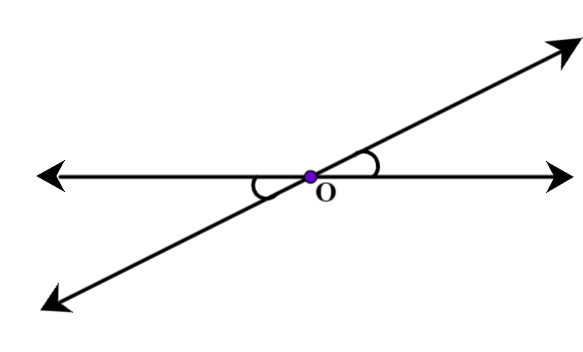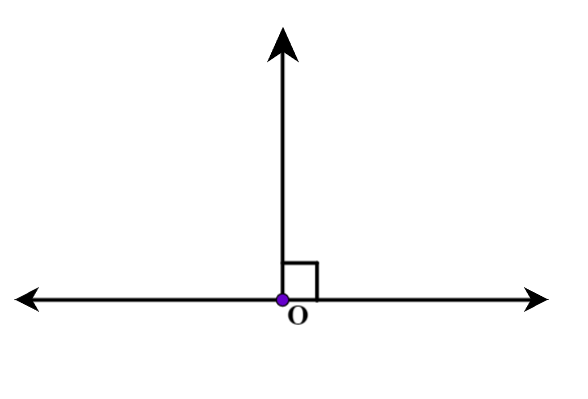
What is the difference between perpendicular lines and intersecting lines?
Answer
498k+ views
Hint: Here in this question we have to mention the difference between the perpendicular lines and intersecting lines. First we know the definition of the perpendicular lines and intersecting lines. Then we can mention the difference between these two topics.
Complete answer: Firstly, we know the definition of a line. A line is a one-dimensional figure, which has length but no width. A line is made of a set of points which is extended in opposite directions infinitely. It is determined by two points in a two-dimensional plane. The two points which lie on the same line are said to be collinear points.
Intersecting lines:
Two or more lines which have exactly one common point are called intersecting lines. This common point exists on all these lines and is called the point of intersection.
The properties of intersecting lines are as follows:
-The intersecting lines meet at one, and only one point, no matter at what angle they meet.
-No two straight lines can meet at more than one point.
In the figure we can observe that two lines are meeting each other at a point O, and the angle between the two lines is not 90 degrees.

Perpendicular lines:
Perpendicular lines are formed when two lines meet each other at the right angle or 90 degrees. This property of lines is said to be perpendicularity.
The properties of perpendicular lines are as follows:
-Perpendicular lines always intersect at right angle
-If any two lines are perpendicular to the same line, then they both are parallel to each other and never intersect.
In the figure we have two lines which meet at a point O and it is exactly 90 degrees.

The only difference between the perpendicular lines and intersecting lines is
Angle is exactly 90 degree in perpendicular lines but it is not in intersecting lines.
Note:
A perpendicular line is called an intersecting line, these lines will meet at the same point and the angle between the lines will be \[{90^ \circ }\]. The difference means the dissimilar properties between the two terms or entities. By considering the diagrams the students can understand the topic in a better way.
Complete answer: Firstly, we know the definition of a line. A line is a one-dimensional figure, which has length but no width. A line is made of a set of points which is extended in opposite directions infinitely. It is determined by two points in a two-dimensional plane. The two points which lie on the same line are said to be collinear points.
Intersecting lines:
Two or more lines which have exactly one common point are called intersecting lines. This common point exists on all these lines and is called the point of intersection.
The properties of intersecting lines are as follows:
-The intersecting lines meet at one, and only one point, no matter at what angle they meet.
-No two straight lines can meet at more than one point.
In the figure we can observe that two lines are meeting each other at a point O, and the angle between the two lines is not 90 degrees.

Perpendicular lines:
Perpendicular lines are formed when two lines meet each other at the right angle or 90 degrees. This property of lines is said to be perpendicularity.
The properties of perpendicular lines are as follows:
-Perpendicular lines always intersect at right angle
-If any two lines are perpendicular to the same line, then they both are parallel to each other and never intersect.
In the figure we have two lines which meet at a point O and it is exactly 90 degrees.

The only difference between the perpendicular lines and intersecting lines is
Angle is exactly 90 degree in perpendicular lines but it is not in intersecting lines.
Note:
A perpendicular line is called an intersecting line, these lines will meet at the same point and the angle between the lines will be \[{90^ \circ }\]. The difference means the dissimilar properties between the two terms or entities. By considering the diagrams the students can understand the topic in a better way.
Recently Updated Pages
Master Class 9 General Knowledge: Engaging Questions & Answers for Success

Master Class 9 English: Engaging Questions & Answers for Success

Master Class 9 Science: Engaging Questions & Answers for Success

Class 9 Question and Answer - Your Ultimate Solutions Guide

Master Class 12 Economics: Engaging Questions & Answers for Success

Master Class 12 Maths: Engaging Questions & Answers for Success

Trending doubts
Which places in India experience sunrise first and class 9 social science CBSE

Fill the blanks with the suitable prepositions 1 The class 9 english CBSE

Write the 6 fundamental rights of India and explain in detail

Difference Between Plant Cell and Animal Cell

What is pollution? How many types of pollution? Define it

What is the Full Form of ISI and RAW




